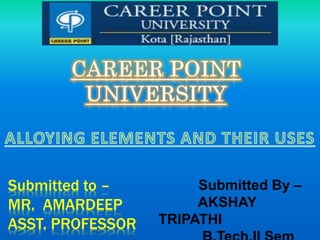Manufacturing
•Download as PPTX, PDF•
4 likes•185 views
Metallic or non-metallic elements are added to base metals in specified amounts to make alloys with new properties. This process is called alloying. Alloying elements include aluminum, boron, chromium, cobalt, copper, manganese, nickel, silicon, titanium, tungsten, vanadium, and zirconium. Alloys have superior qualities like corrosion resistance, electrical conductivity, hardness, or strength compared to base metals. Common alloys used in daily life include those used in kitchen utensils, vehicles, computers, phones, and medical and engineering equipment. Steel is an important alloy of iron and carbon, and different amounts of carbon or additional alloying elements give steel properties suitable for different applications.
Report
Share
Report
Share

Recommended
Recommended
More Related Content
What's hot
What's hot (20)
Viewers also liked
Viewers also liked (6)
Similar to Manufacturing
Similar to Manufacturing (20)
Presentation 1 - Uses of various steel in Construction.pptx

Presentation 1 - Uses of various steel in Construction.pptx
Recently uploaded
Recently uploaded (20)
Halogenation process of chemical process industries

Halogenation process of chemical process industries
A CASE STUDY ON ONLINE TICKET BOOKING SYSTEM PROJECT.pdf

A CASE STUDY ON ONLINE TICKET BOOKING SYSTEM PROJECT.pdf
Introduction to Machine Learning Unit-5 Notes for II-II Mechanical Engineering

Introduction to Machine Learning Unit-5 Notes for II-II Mechanical Engineering
Cloud-Computing_CSE311_Computer-Networking CSE GUB BD - Shahidul.pptx

Cloud-Computing_CSE311_Computer-Networking CSE GUB BD - Shahidul.pptx
RESORT MANAGEMENT AND RESERVATION SYSTEM PROJECT REPORT.pdf

RESORT MANAGEMENT AND RESERVATION SYSTEM PROJECT REPORT.pdf
KIT-601 Lecture Notes-UNIT-5.pdf Frame Works and Visualization

KIT-601 Lecture Notes-UNIT-5.pdf Frame Works and Visualization
Online blood donation management system project.pdf

Online blood donation management system project.pdf
Introduction to Casting Processes in Manufacturing

Introduction to Casting Processes in Manufacturing
NO1 Pandit Black Magic Removal in Uk kala jadu Specialist kala jadu for Love ...

NO1 Pandit Black Magic Removal in Uk kala jadu Specialist kala jadu for Love ...
Manufacturing
- 1. Submitted to – MR. AMARDEEP ASST. PROFESSOR Submitted By – AKSHAY TRIPATHI
- 2. WHAT ARE ALLOYING ELEMENTS? Metallic or non-metallic elements such as aluminum, boron, chromium, cobalt, copper, manganese, nickel, silicon, titanium, tungsten, vanadium, zirconium, added in specified or standard amounts to a base-metal to make an alloy that changes its properties and structure. Alloying adds new or superior qualities to the base metal, such as corrosion resistance, electrical conductivity or resistance, greater hardness, softness, or strength, etc.
- 3. Alloying metals are used in making alloys and Alloy material has very important role in our daily life even there won't be a day passed without using alloy. • Our utensils in the kitchen, • Vehicles, • Computers, • Mobile phones, chairs etc. • Most of the engineering and medical equipments, machineries, tools are made by USES
- 4. SOMETHING ABOUT ALLOY….. Various alloys have different properties like Strength Malleability Visual attractiveness. Copper and tin are used to make Bronze, an important alloy harder than copper. This quality has been utilized for imprint the civilization and history of mankind for thousands of years called bronze age. In our daily life, mankind uses alloys in almost all of the fields that uses metals. Most known elements have involvement in making alloys thus we have tens of thousands of alloy products. Alloys are attractive due to its improved quality for make utilizing the pure elemental metals.
- 5. STEEL, AN IMPORTANT ALLOY. Iron-based alloy containing at least 0.5 percent silicon, 0.6 percent copper, 1.65 percent manganese. Minute quantities of chromium, nickel, molybdenu m, and/or tungsten. Steel that does not contain specified or standard amount of one or more alloying elements is termed carbon steel.
- 6. Carbon Steel Stainless Steel An alloy of iron and carbon Alloy of iron and chromium Can rust Doesn’t rust Hard and wear-resistant Softer. Brittle Non-brittle.
- 7. ALUMINIUM (AL) Most powerful de-oxidiser used which also combines with nitrogen, thereby reducing the susceptibility to strain ageing. Small additions assist fine- grained structure. As aluminium forms very hard nitrides with nitrogen, it is usually an alloying element in nitriding steels. Aluminium improves the scale resistance and is therefore often used as an alloying element in ferritic heat resisting
- 8. CARBON (C) Carbon is the most important and influential alloying element in steel. In addition to Carbon every unalloyed steel contains Silicon, Manganese Phosphorus and Sulphur which occur unintentionally during manufacture. The addition of further alloying elements to achieve special effects and intentional increase of Manganese and Silicon contents, results in alloy steel. With increased Carbon content the strength and hardenability of steel increase but its ductility, forgeability and machinability reduces. The carbon content in steel has virtually no effect on the steels corrosion resistance to water, acids and hot gasses.
- 9. CHROMIUM (CR) Chromium increases the hardenability while the ductility is effected minimally. Higher Chrome content in steel increases its corrosion resistance. Forms carbides by which the edge holding quality of steel increases. The tensile strength of steel increases by 8 - 100 N/mm'2 for every 1 % chrome added. The yield strength also increases but the notch impact value reduces.
- 10. MANGANESE (MN) Manganese increases the strength of metal to a lesser degree than Carbon. But favourably influences the forgeability, weldability. Increases the hardness penetration depth.
- 11. NICKEL (NI) By adding Nickel to steel the notch toughness is increased significantly and is therefore alloyed for increasing toughness in case- hardening. Heat-treatable and subzero toughness steels. Nickel combined with Chromium ensures good through hardening. Chrome-Nickel steels are Stainless, heat resistant and resistant to scaling.
- 12. SOME OTHER ALLOYING ELEMENTS Molybdenum (Mo) Phosphorus (P) Lead (Pb) Sulphur (S) Silicon (Si) Vanadium (V)
- 13. THANK YOU